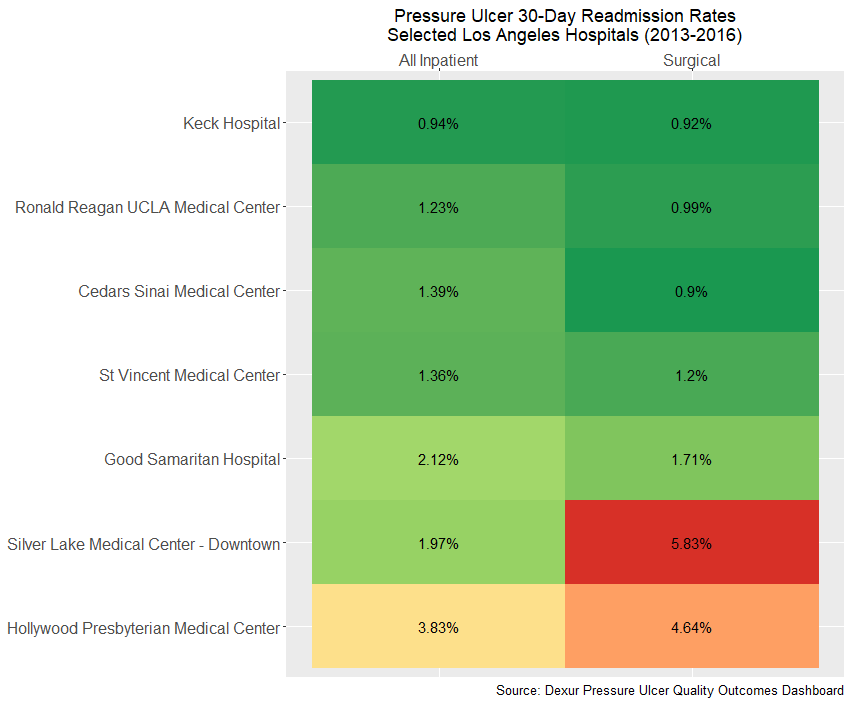Pressure Ulcer Readmission Rates in Los Angeles Area Hospitals Range From 0.94% to 3.83%
In Pressure Ulcer
Get Dexur’s Personalized Hospital Specific Presentation on Quality, Safety, Compliance & Education
By: James Pitt Jul. 20, 2018
Pressure ulcers are wounds that develop due to reduced blood flow, typically in patients who lie in the same position for long periods. Elderly and critically ill patients are at particular risk. A study based on 2006-2007 Medicare data found that patients with pressure ulcers are more likely to die in-hospital (odds ratio 2.81); have more than double the average length of stay; and are more likely to be readmitted within 30 days of discharge (odds ratio 1.33).
Nationally, patients discharged after surgery are at slightly higher risk of being readmitted with pressure ulcers within 30 days. From 2013 to 2016, 1.37% of surgical patients and 1.29% of all inpatients were readmitted with pressure ulcers within 30 days of discharge.
Dexur analysts examined pressure ulcer readmissions at the seven largest Los Angeles, California hospitals in 2013-2016 Medicare data. This covers a total of 172,938 inpatient discharges. Two hospitals had lower 30-day pressure ulcer readmission rates than the US average: 0.94% at Keck Hospital, and 1.23% at Ronald Reagan UCLA Medical Center.

In surgical patients specifically, all four of the largest hospitals had lower pressure readmission rates than the US average: the above two plus Cedars Sinai Medical Center (0.9% 30-day readmissions rate in surgical patients) and St Vincent Medical Center (1.2%).
Pressure ulcer readmission rates were higher at Silver Lake Medical Center - Downtown (5.83%) and Hollywood Presbyterian Medical Center (4.64%). These hospitals have lower volumes of surgical patients than the hospitals with more favorable surgical pressure ulcer readmission rates.
Pressure ulcers tend to heal slowly, so guidelines such as the NCBI recommendations for emphasize prevention over treatment. Unfortunately, providers cannot expect to identify every at-risk patient in advance. The 2015 ACP clinical practice guideline found that the moderate-quality evidence that the most widely used risk assessment scales “had low sensitivity and specificity to identify patients at risk for pressure ulcers.”
There are numerous options for pressure ulcer treatment. A 2007 Johns Hopkins review enumerated no less than 16 product categories, and available biologic dressings and negative-pressure therapies have considerably diversified since then.
DEXUR PRO MEMBERS GET ACCESS TO:
- Total Discharges ( Jan 2013 to Dec 2016 )
- Total Discharges After Exclusion
- All Cause 30 Day Readmissions
- 30 Day Pressure Ulcer Readmissions
- 30 Day Pressure Ulcer Readmission Rate (%)
- State 30 Day Pressure Ulcer Readmission Rate (%)
- National 30 Day Pressure Ulcer Readmission Rate (%)
- % 30 Day Readmissions back to Same Hospital
- 30 to 60 Day Pressure Ulcer Readmissions
- 30 to 60 Day Pressure Ulcer Readmission Rate (%)
- State 30 to 60 Day Pressure Ulcer Readmission Rate (%)
- National 30 to 60 Day Pressure Ulcer Readmission Rate (%)
For all inpatients and for surgical patients, at the following hospitals:
- Cedars Sinai Medical Center (Los Angeles, California)
- Ronald Reagan UCLA Medical Center (Los Angeles, California)
- Keck Hospital (Los Angeles, California)
- St Vincent Medical Center (Los Angeles, California)
- Good Samaritan Hospital (Los Angeles, California)
- Silver Lake Medical Center - Downtown (Los Angeles, California)
- Hollywood Presbyterian Medical Center (Los Angeles, California)
ABOUT THE AUTHOR
